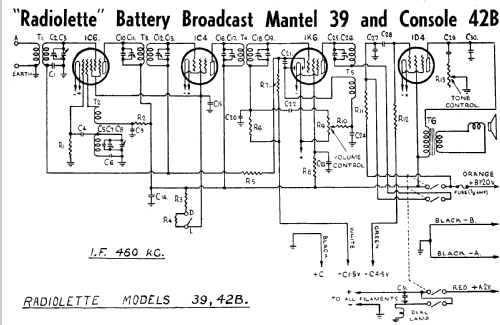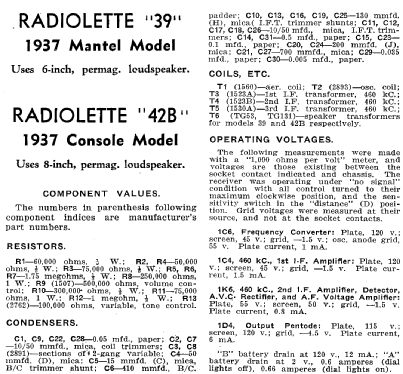Radiolette (Fret and Foot) 39B Ch= 39
Amalgamated Wireless (Australasia) Ltd. (AWA); Sydney
- País
- Australia
- Fabricante / Marca
- Amalgamated Wireless (Australasia) Ltd. (AWA); Sydney
- Año
- 1937
- Categoría
- Radio - o Sintonizador pasado WW2
- Radiomuseum.org ID
- 165091
Haga clic en la miniatura esquemática para solicitarlo como documento gratuito.
- Numero de valvulas
- 4
- Principio principal
- Superheterodino en general; ZF/IF 460 kHz; 2 Etapas de AF; Reflex
- Número de circuitos sintonía
- 6 Circuíto(s) AM
- Gama de ondas
- OM (onda media) solamente
- Tensión de funcionamiento
- Red / Acumuladores (posiblemente también baterias) / 120 & 2 & -1.5 & -4.5 Volt
- Altavoz
- Altavoz dinámico (de imán permanente) / Ø 6 inch = 15.2 cm
- Material
- Inyectado (se desconoce si bakelita o plástico).
- de Radiomuseum.org
- Modelo: Radiolette 39B Ch= 39 - Amalgamated Wireless
- Forma
- Sobremesa alto de forma simple.
- Ancho, altura, profundidad
- 308 x 337 x 225 mm / 12.1 x 13.3 x 8.9 inch
- Anotaciones
-
AWA produced a series of Bakelite, Fret and Foot radios in 1936 and 1937.
Radiolette models R33, R33A, R35, R35A, R38A, R38B, R38C, R39A, R39B, R39C, R40A, R40B and R40C.
The Model 39B was produced with a grained Ivory cabinet, fret and feet.
Fret and Foot was not the official AWA name for the classic Fisk Tombstone Radiolette but they are unique with a cabinet of a square block of Bakelite along Art Deco lines with curved edges which are complemented by a contrasting colour, Asian influenced speaker grill fret and Lion’s paws as feet.
The unique design is a tribute to the Bakelite designer’s art of the era which made them very appealing to worldwide collectors
They are now known colloquially as the AWA Radiolette, Fret and Foot series of radios.
- Precio durante el primer año
- 21.00 Aus£
- Referencia esquema
- Australian Official Radio Service Manual Vol. I
- Mencionado en
- AORSM vol.1 206.
- Documentación / Esquemas (1)
- "AWA Radiolettes 1932-1949"
- Documentación / Esquemas (2)
- Radio Trade Annual of Australia (1939 Page 296)
- Autor
- Modelo creado por Stuart Irwin. Ver en "Modificar Ficha" los participantes posteriores.
- Otros modelos
-
Donde encontrará 1433 modelos, 877 con imágenes y 464 con esquemas.
Ir al listado general de Amalgamated Wireless (Australasia) Ltd. (AWA); Sydney


